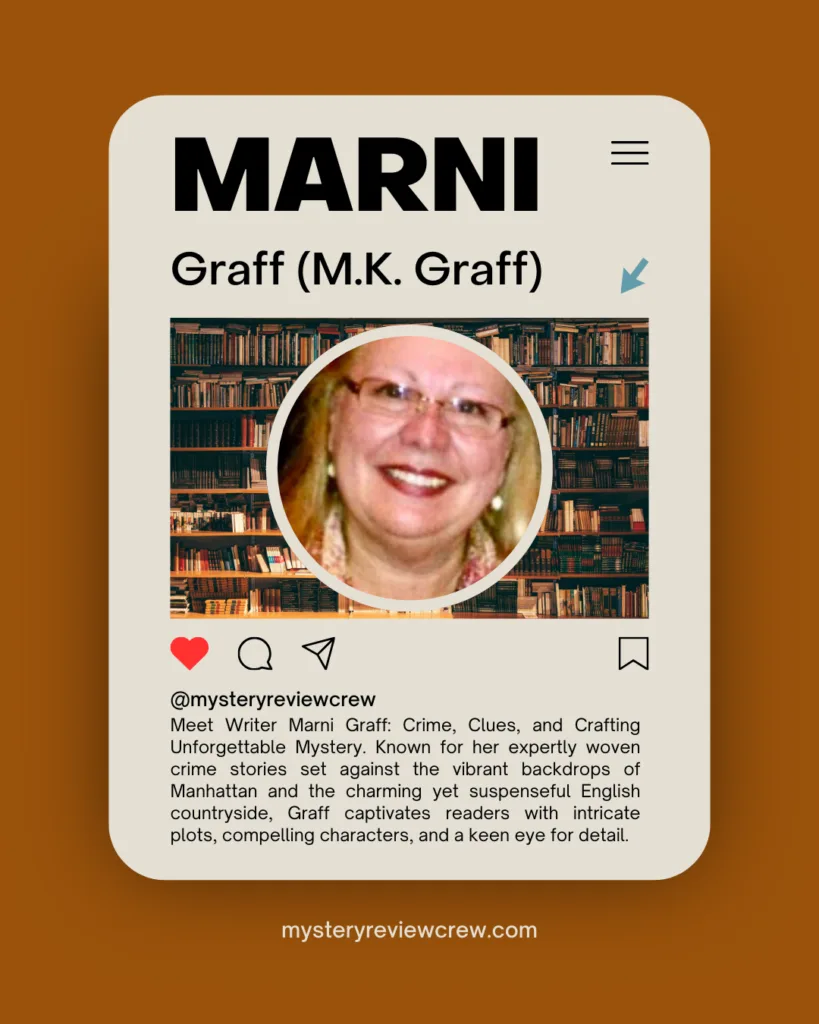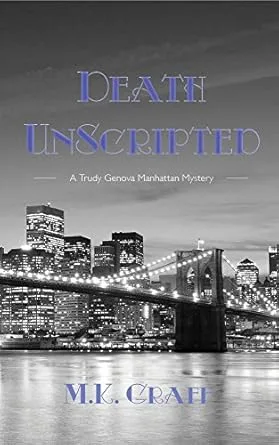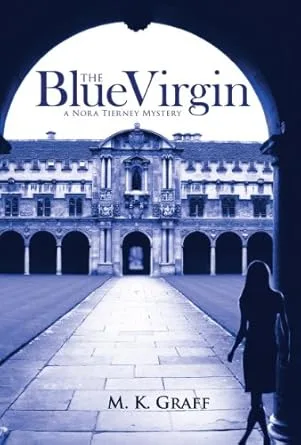This month, we’re diving into the world of mystery with award-winning author Marni Graff (AKA M.K. Graff)! Known for her expertly woven crime stories set against the vibrant backdrops of Manhattan and the charming yet suspenseful English countryside, Graff captivates readers with intricate plots, compelling characters, and a keen eye for detail.
A little about Marni Graff

Marni K. Graff (M. K. Graff) writes award-winning murder and mayhem stories set in England and Manhattan.
Marni Graff wears multiple hats in the literary world. Not only is she the Managing Editor of Bridle Path Press, an author’s cooperative nestled in the heart of Baltimore, Maryland, but she also has a popular crime review blog, Auntie M Writes. Furthermore, she graces the pages of The Miss Demeanors blog as a monthly contributor.
Death in the Orchard brings Trudy Genova back to her rural hometown of Schoharie. What motivated you to shift the setting from New York City to a small-town environment, and how does this change impact the dynamics of the story?
I’ve always been leery of keeping a sleuth in one setting to avoid the “Jessica Fletcher syndrome.” How many murders can there be in one place?! In Nora Tierney’s case, I moved her around England, but for Trudy Genova, who lives and works in Manhattan, where the first two books are set, I moved the action to her hometown to vary the setting. It changed the dynamics from the frenetic activity in a metropolitan area like New York City to contrast against a very rural upstate NY town in the Catskill Mountains. The idea flowing through the story was that here, amongst the orchards and rolling hills of a sleepy area, where Trudy goes to investigate basically a cold case and has the luxury of taking her time that fits that setting, a new murder suddenly brings a strong dichotomy to the reader.
Trudy’s quest to uncover the truth behind her father’s death is deeply personal. How did you approach writing about Trudy’s emotional journey, and what challenges did she face in balancing her investigative instincts with family loyalty?
Trudy has always wanted to dig into her father’s death, which had been ruled ‘accidental’ at the time he died eleven years ago. Yet for Trudy, who was sixteen at the time, his death became the death of her teenage years. Mario Genova was actually picking up party things for her Sweet Sixteen when he was found dead. Besides the party being canceled, of course, Trudy set her sights on nursing school and moved away after graduation to escape the idea of murder, the loss of a safe place at home, and to grieve her loss. But now that she’s home and needing to investigate his death fully, she also realizes that this sword has more than one edge! Not everyone in her family will welcome this foray into her father’s death for their own reasons. And what if she uncovers that Mario was involved in something illegal or salacious that led to his death? It’s a fine line she’s walking here, so my goal was for Trudy to not come across as hard-hearted about her family’s opinions and to balance that with trying to keep her real reasons for coming home to herself, at least at first. That soon becomes impossible, and she is forced to see that Mario’s death meant different things for each member of her immediate family, which opens her eyes.
NYPD detective Ned O’Malley accompanies Trudy with a dual purpose. How does his relationship with Trudy evolve throughout the novel, and what complexities arise from his secret mission to investigate her father’s death?
Ned and Trudy had only been intimate for several weeks but had known each other for months when she asked him to travel home with her to look into her father’s death. A baby shower for her brother’s first child is the excuse they give for the trip, but to Ned, a person of high moral character, he’s uncomfortable keeping their real reasons from Trudy’s family, in the same way he’s uncomfortable sleeping with her under her mother’s roof. One of the hallmarks of their attraction to each other is that he is drawn to her knowledge of human nature, and has come to respect it, as well as her ability to brazen out tough situations. When they come across an old boyfriend of Trudy’s, he’s surprised at his jealous streak and realizes how deeply Trudy has gotten under his skin.
At the same time, he’s a professional detective, and so he must integrate how he carries out looking into Mario Genova’s death with a kind of distance uncolored by his feelings for Trudy to get to the truth, despite her insistent belief her father was murdered, all the while keeping their real mission from the family he’s trying to impress. At times, he must feel as if he’s walking a tightrope!
Mario Genova’s mysterious actions before his death left many unanswered questions. How did you develop the backstory of Mario’s character, and what key themes did you want to explore through the family’s history and secrets?
When Mario was found dead, his truck was filled with food and supplies for the orchard shop and for Trudy’s impending Sweet Sixteen. But her family soon found out that the day before his death, he wiped out his and his wife’s savings and retirement accounts. The reasons behind why he did this form one of the biggest mysteries connected to his death, in addition to who killed him, of course. The WHY of his actions becomes a sticking point for Trudy. “Do people really change so much, or are they able to hide a devious nature?” is one area I explored. Another was how different people react to the same situation, in this case, the impact of Mario’s death on each member of Trudy’s family. Trudy will learn her brother Ben stepped into her father’s business role but didn’t feel he had the luxury of looking too deeply into their father’s actions; younger brother Rick left his dream of garden architecture design and found a way he could combine his love of nature with working at the orchard. Even Trudy’s Mom, Hildy, had her doubts about Mario having a secret life, and Trudy learns her mother went through stages of anger and disbelief before finally deciding she knew Mario better than anyone else, and he must have a good reason for his actions, albeit one she hasn’t been able to discern. At the end of the day, we act and react from our own perspective that may differ for each person, even in a close family.
The occurrence of a new death on Trudy Genova’s Orchard property adds another layer of tension. How did you weave this new mystery into the existing narrative, and what significance does it hold for Trudy and her family?
When a new death occurs on the orchard property, it affects Trudy and her family on several levels. Beyond the obvious sadness of someone losing his life, there is the idea that, possibly now, their family will once again be the center of media attention. Even more pressing is that Trudy’s brother, Rick, who discovered the body on his front steps, is considered a suspect. I wove it in by setting the stage for Trudy and Ned’s initial investigation on their first day home, and then on the early evening of the second day when the death occurs, those things have their own natural flow of working in a definitive murder case, the steps that must be followed, that led quite naturally in the action. For instance, after Rick, accompanied by Trudy, gives his formal statement on finding the body the next day at the police station, they then offer their respects to the victim’s family. By showing the family of the victim, a recently paroled drug offender, and how his parents and brother reacted to this death, I was able to give the reader information about the victim’s background and upbringing.
Can you share your journey to becoming an author? What inspired you to pursue a writing career?
I’ve always written, because I’ve loved books and reading since being one of two students able to read when I started kindergarten. The other gal is still my best friend all these years later! I wrote poetry and essays in high school, worked on the school paper, and wrote feature articles for a nursing journal after that. I was a registered nurse for 30 years who wrote ‘on the side’ and studied many forms of writing, knowing my goal when I left nursing was to be a novelist. I chose crime novels because those are the books I enjoy reading the most. I remember being in plays and musicals in high school, which I loved, and thinking of pursuing an acting career, but reading has always been my passion, and I decided I wanted to reach people that way instead.
Knowing my goal was to write a crime novel, I eventually honed my studies in that genre, from gothic literature to contemporary crime. I read and review books, too, about three a week, so have always kept up the reading side and feel any writer must be a reader to be successful. We learn from stories we love and stories that fall flat, right? I was getting ready to start the Nora Tierney series and was studying one summer at Oxford University while researching settings for that novel, when the magazine I was currently doing interviews for, Mystery Review, asked me to take the train down to London to interview PD James, the contemporary Queen of British Crime and a personal heroine. We developed a mentoring friendship that lasted the last 15 years of her life, for which I am eternally grateful. She is the one who made me promise to write a second series once I had a few Noras in print, one whose protagonist would have my favorite real nursing job: working as a medical consultant for a NY movie studio. She said readers would enjoy learning a behind-the-scenes look at that position, and the first in the Trudy series, Death Unscripted, is dedicated to her.
Of course, writing a novel doesn’t mean it will be published, and I had many close calls with big NY houses once I had an agent at Curtis Brown, Ltd, but finally brought out my books with a small indie press out of Baltimore, Bridle Path Press, which allows me to retain creative control over my things like my cover and layout. It suits me, and all of my eight mysteries over two series have been through Bridle Path Press.
Are there any specific authors or books that influenced you early in your writing journey?
Being a huge mystery fan, I’d say Agatha Christie hooked me, and all the golden agers like Dorothy Sayers and Ngaio Marsh were early influences and still are. There’s a reason Christie is only outsold by Shakespeare and the Bible: her storytelling abilities are far greater than may appear on the surface. Daphne du Maurier is another influence, with Rebecca one of my favorite novels of all time. Wilkie Collins is another, and I gave Trudy a cat named after him!
Are you a planner or a “pantser” (writing by the seat of your pants)? How do you approach structuring your stories?
I’ve learned that I must have a certain degree of organization, likely due to all those years of nursing! I do a lot of research into my story in terms of setting, the murder method, etc., and set up several main characters, creating bibles for them of their backgrounds, before starting to write. That gives me a broad structure to operate from–and reduces my fears of never finishing.
The first thing I decide is the end: who is murdered and WHY. Then I outline the beginning chapters and set off, allowing the characters and their story to find my way to that ending by happenstance
I call the muddle middle the part that slows me down and find if I walk away and come back to the manuscript the next day, overnight I’ve been thinking and ‘pre-writing’ in my head while I’m making dinner or trying to get to sleep, and it works out.
So, I suppose you’d call me a hybrid.
How do you develop and bring your characters to life? Are they ever inspired by real people or experiences?
Some photos of people I might see in a magazine may inspire appearances, but for me, each character is someone unique. Those who play a role in the story will have me create a bible for each one, that goes beyond their appearance to think of where they came from and what their backgrounds are. Are they educated? Did they come from a large extended family or were raised an orphan? The two big questions I always jot down are: what does this character WANT the most; and what does this character FEAR the most.
Do you have a favorite genre or style to write in, or do you enjoy experimenting with different forms of storytelling?
This is a great question because I am getting ready to embark on my first standalone, a historical novel set in 1926 Yorkshire. I have a pretty good handle on crafting my mysteries after eight of them, which are all a mix of amateur sleuth and police procedural. I enjoy showing the story unfold through Nora or Trudy’s eyes as the amateur, and then the way the police go about investigating the crime from the POV of whatever detective is involved. So, this historical is a distinct departure for me designed to grow me as a writer, and I’m excited and scared in equal measure!
I’ve also changed up the types of crime novels from time to time and experimented with that within mystery conventions. Death in the Orchard and The Evening’s Amethyst both revolve around a cold case that soon adds a current murder. One of the Noras, instead of being a Whodunit? is a Cantheystophim? In that one, The Golden Hour, the reader knows upfront who the bad guy is and what his plans are, and the race is to prevent him from carrying that out, even while Nora’s little boy is in jeopardy. That one was the first one to have a psychopath as a main character and I had great fun writing someone so diabolical while still finding a small nugget of a place where readers could connect with him. I did that by showing the incident that sets him on his current course, and by having him call home to remind his gardener to deadhead his roses.
I don’t want readers to feel they are reading the same book over and over…So, these kinds of things stretch me as a writer and, I hope, keep the reader intrigued.
Are there specific themes or recurring motifs that you find yourself exploring in your writing?
I’ve seen that one theme that recurs for me is the idea of family. At times, we find ourselves creating a family that consists of those we surround ourselves with, almost a community, if you will. This is true for both Nora and Trudy, whose biological families live at a distance. There is also a kind of relief in having friends who function as family in terms of support, guidance, and help, but who are unaware of the day-to-day intricacies of your biological family. In that way, the character can leave some memories and situations behind, if they were painful. The ‘new’ family doesn’t know things they’d prefer to leave behind if they are painful, but only know what Nora or Trudy have chosen to share. And the things they leave behind may not be criminal, they may simply be painful episodes the character wants to lose focus on, so while they are always a part of these characters, they have reinvented themselves and can choose to share these details or not.
And for readers with a close eye, in every book in both series I always have Nora or Trudy see someone walking a Scottie dog with a tartan collar!
How do you approach writing dialogue to make it feel authentic and engaging for readers?
When I was studying different forms of writing, I wrote several screenplays, which are almost all dialogue with stage directions of action. That experience was beneficial when I started writing novels. To stay authentic, I have to remember how people really speak: we step on each other’s lines, as it were; we trail off in the middle of a thought; and often, two characters are speaking to each other, but there is more happening between them than is being said. Also, real people speak with contractions. They rarely say things like “I am on my way” versus “I’m on my way.” If you read your manuscript aloud, you will easily pick up any dialogue that sounds stilted or unreal.
What advice would you give to aspiring authors who are just starting their writing journey?
When I taught creative writing, I always started with the premise that to be a writer, you must be a reader. Read everything and anything, even the back of cereal boxes, to see what words were chosen to promote a brand. Read heavily in your chosen genre, of course, but also dip onto others. And don’t neglect the classics. Those books have endured for a reason: they are darn good stories. Note how Wilkie Collins, Dickens, or Du Maurier build character with telling details and how they use setting to increase tension. See how Alcott’s Little Women or Austen’s Pride and Prejudice evoke emotions on both ends of the scale, from joy to sorrow.
Then, find yourself a writing group. It can be one person who gives good critiques or a larger group. Use them for their feedback, but be aware that our own views and likes/dislikes come into critiquing, so be judicious about using that feedback. If you are in a group of, say, 5, and one person doesn’t like the amount of profanity a character uses, maybe reread that part and see if you, as the author, agree, or if that rings true to the way you’ve written that character. But if 3 or 4 of that group point out an area where your pace lags, you’d better pay attention to that.
If you could have dinner with any fictional character, who would it be and why?
I’m tempted to say Adam Dalgliesh, because PD James wrote that enigmatic character, and because I miss her very much, and who wouldn’t want to share a table with Sherlock Holmes– but then I fear he’d watch every morsel I put in my mouth and deduce something from that!
I’d choose to have dinner with Miss Jane Marple and pick her brain. Due to the historical I’m writing, I’ve read every biography of Christie and learned “Marple” was a place name Christie saw on a railway sign. I think Miss Marple’s view of human nature, gleaned from her observations in small English villages, is a real sign of the times for those books, and shows how much can be gleaned by simply observing people and their actions. I’d explore her background that made her a spinster and how she feels about staying true to the young man she lost in WW1 who was her true love. I also think she’d give us a running commentary on the young waiter who serves us!
Check out Marni Graff’s mystery novels
*Affiliate links are used in this article. The Mystery Review Crew is an Amazon Affiliate and, as such, earns from qualifying purchases. See our privacy policy and disclosures for more information.
The first book in the Trudy Genova Manhattan Mysteries series is Death Unscripted.
Trudy Genova has the best job any nurse could want, working on set as a medical consultant for a NY movie studio. No more uniforms, bedpans, or emergencies until the actor whose overtures she’s refused dies suddenly while taping a hospital scene–but not before pointing his finger accusingly at Trudy. When detectives view Trudy as a suspect, she sets out on an investigation to clear her name. Then a second death occurs, and Trudy realizes she’s put herself in jeopardy.
A new mystery from the award-winning author of the Nora Tierney English Mystery Series, DEATH UNSCRIPTED, is based on the author’s real work experience during her nursing career and is the mystery series British Queen of Crime P. D. James insisted she write. A mix of amateur sleuth and police procedural, the story is told in first person from Trudy’s point of view, and in third from NYPD Detective Ned O’Malley.
On Goodreads, Amazon, and Bookbub.
Other books in the series: Death at the Dakota, Death in the Orchard.
M.K. Graff’s second series, The Nora Tierney English Mysteries, starts with The Blue Virgin.
Despite a planned move, the mysterious death of photographer Bryn Wallace keeps American writer Nora Tierney glued to Oxford in order to clear her close friend, artist Val Rogan, who has been wrongfully accused of Bryn’s murder. Or has she? Nora quickly becomes embroiled in the murder investigation, much to the dismay of two men: Detective Inspector Declan Barnes, the senior on the case; and Simon Ramsey, the illustrator of Nora’s children’s book.
Simon’s efforts to save Nora from herself become increasingly frantic as Nora is forced to push her way into Declan’s case, using her wits and her wiles to prove Val’s innocence.
The first in a series of Nora Tierney mysteries based in the UK, THE BLUE VIRGIN is a compelling story of love and intrigue. Nothing, Nora learns, is what it seems, and even the most innocent of choices can lead to murder and revenge. Set in the ancient city of golden spires, the setting lends itself to mystery, as any Inspector Morse fan will agree. The novel is written in classic English style, complete with a Cast of Characters and chapter epigraphs which add to its literary feel.
On Goodreads, Amazon, and Bookbub.
Other books in the series: The Green Remains, The Scarlet Wench, The Golden Hour, and The Evening’s Amethyst.
Love this interview? See more of our past Author Interrogations Interviews.








Fascinating interview! I love Marni’s work.
Thank you! Marni is really fun to work with, and I’ve really enjoyed getting to know her over the last few years.
-Kimmie